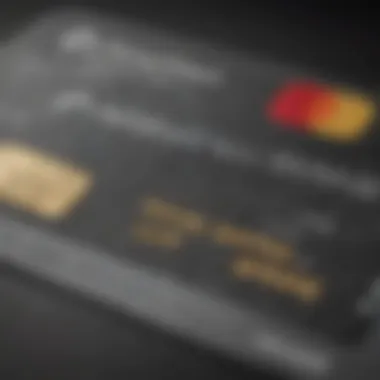Understanding Direct Deposit Cards: A Comprehensive Guide


Intro
In the evolving landscape of personal finance, understanding different financial products is crucial. The direct deposit card has established itself as a noteworthy option, providing a stream of advantages for consumers. This guide seeks to illuminate the essence, benefits, and functionalities of direct deposit cards while comparing them to traditional banking solutions. Individuals across varying economic backgrounds can find relevance in this topic, whether it's for managing paychecks, handling government benefits, or maintaining budgeting structures.
Overview of the Topic
Definition and Importance of the Topic
A direct deposit card is a prepaid debit card designed to receive its funding through electronic direct deposits. This product effectively eliminates the need for a physical bank branch for transactions. Funds can be loaded from various pay sources, including payroll, government benefits, and even tax refunds. The significance of direct deposit cards lies in their ability to offer easy access to funds without the bureaucratic hurdles associated with traditional banking.
Key Benefits and Implications
The benefits of direct deposit cards are numerous. These cards typically provide:
- Convenience: Funds are instantly available, and there’s no wait for physical checks to clear.
- Accessibility: Users can withdraw cash and make purchases without a linked bank account.
- Budgeting Ease: Many prepaid cards come with budgeting tools, allowing individuals to track spending and savings effectively.
For those in search of fast tracking their financial management, understanding direct deposit cards becomes essential.
Exploring Strategies and Tips
Practical Tips for Implementation
To maximize the utility of a direct deposit card, consider the following strategies:
- Always read the fine print associated with terms and fees.
- Opt for services that allow for free access to your money. Certain cards might impose surcharges or monthly maintenance fees which can diminish financial advantages.
- Familiarize yourself with the reloading options available for your card to ensure smooth access to funds.
Strategies for Effective Management
For managing your direct deposit card effectively, implement these practices:
- Set alert notifications for spending thresholds.
- Keep a record of balances to avoid overspending.
- Utilize app features for tracking transactions.
Comparison of Financial Products
Direct deposit cards warrant comparison with other financial products. When looking at checking accounts, the differences unfold:
- Fees: Many bank accounts charge monthly fees, while direct deposit cards, in certain cases, may have no fees at all.
- Accessibility: With direct deposit cards, users can access cash directly without depending on banking hours.
Key takeaway: Make informed decisions based on your financial habits and preferences.
Expert Insights and Recommendations
Financial experts emphasize the practicality of direct deposit cards for individuals who want financial flexibility without the commitments of a traditional account. It’s crucial to:
- Research various product offerings from different providers.
- Understand regional use cases and regulations that may influence card utility.
- Consider combining a direct deposit card with a savings or investment account as part of a broader financial strategy.
By keeping these factors in mind, consumers can leverage the benefits of direct deposit cards effectively while making informed financial decisions. Understanding these intricacies supports smarter management of personal finances.
Preamble to Direct Deposit Cards
Understanding direct deposit cards is crucial for individuals seeking efficient ways to manage their finances. These cards represent a modern approach to accessing salary payments and government benefits in a format that suits many users. Unlike traditional methods, these cards provide prompt access to funds with less hassle.
Definition of Direct Deposit Cards
Direct deposit cards are prepaid debit cards linked directly to a bank account or a financial institution's electronic funds service. Employees or beneficiaries can receive their payments directly onto these cards, rather than relying on paper checks or cash. With these cards, users can manage their funds digitally, eliminating the need for paper checks or physical bank trips.


Purpose of Direct Deposit Cards
The primary purpose of direct deposit cards is to facilitate quick and easy access to money. Also, they serve as a secure alternative to cash. Here are some notable purposes of direct deposit cards:
- Streamlined payments: Users have their wages, pensions, or benefits transferred instantly without delays associated with checks.
- Accessibility: Direct deposit cards can often be used anywhere standard debit or credit cards are accepted. This makes shopping and bill payments more convenient.
- Financial management: Many users leverage the budgeting tools available with these cards. It allows budgeting easily and tracking expenses effectively.
How Direct Deposit Works
Understanding how direct deposit works is crucial as it lays the foundation for the effective usage of direct deposit cards. This section explains not only the technical aspects but also the significance of direct deposit in today's financial ecosystem. Direct deposit streamlines the payment process, making it easier for employers and employees to transact efficiently. In essence, it dos away befuddling processes of checks and fees tied to traditional banking systems.
The Mechanics of Direct Deposit
Direct deposit is a method used to transfer funds electronically from one banking account to another. Here are the basic steps involved in the process:
- Authorization: The employee must authorize direct deposit with their employer, providing the necessary banking details.
- Transmission: On payday, the employer transmits an electronic funds transfer (EFT) request to their bank which includes payment information for employees.
- Processing: The employer’s bank then routes those funds through a secure network to each employee’s specific bank.
- Funds Availability: The banks record the funds' arrival, leading to an immediate reflection in the employees’ accounts.
Using direct deposit not only enhances speed and efficiency but also mitigates issues like lost or stolen checks.
Setting Up Direct Deposit
Setting up direct deposit is typically a straightforward process, serving multiple advantages. Here is a general overview of what an individual may expect:
- Gather Necessary Information: You must collect essential data including banking accounts and routing numbers.
- Complete Enrollment Form: Most employers will provide a form to fill when initiating direct deposit, often requiring details mentioned above.
- Verify with Banking Institution: It is wise to confirm with your bank to ensure all information is accurate before submitting.
- Patience during Processing: Usually, the change from paper checks to direct deposit doesn’t take effect immediately and may take one payment cycle to activate fully.
Comparison with Traditional Bank Accounts
When considering financial options, understanding the distinctions between direct deposit cards and traditional bank accounts is key. Knowledge of these differences can aid consumers in making informed choices about managing their money. Direct deposit cards offer unique advantages and limitations, which can impact one’s financial strategies. It is essential to evaluate factors like access, fees, and security when comparing these options.
Direct Deposit Cards vs.
Checking Accounts
Direct deposit cards function similarly to checking accounts in that they allow funds from direct deposits to be accessed easily. However, they differ in various crucial aspects. While checking accounts typically offer a wider range of services, direct deposit cards provide straightforward access to wages and government benefits via electronic means. Here are significant distinctions to note:
- Account Operations: Direct deposit cards seldom offer features inherent to traditional checking accounts, such as check-writing options or minimum balance requirements.
- Ease of Use: Direct deposit cards are often easier to operate for people without bank accounts. They can be managed online or through mobile applications, adding flexibility, especially for those who prefer minimal banking interaction.
- Funding Sources: With checking accounts, users can deposit money through various channels that may not be available with direct deposit cards. These traditional accounts might allow multiple funding options, including cash deposits.
The choice between these two financial tools ultimately relies on personal circumstances and needs. Individuals with a normal banking history may find checking accounts more accommodating and full-featured.
Benefits of Using a Direct Deposit Card
Direct deposit cards bring numerous advantages which might appeal to specific individuals in various situations. While they may not fully replace traditional banking options, their benefits are particularly relevant for those without access to standard banking systems. Here are several benefits to consider:
- Swift Access to Funds: Recipients of direct deposits obtain immediate access to funds, which enhance liquidity. This feature is ideal for people dependent on recurring deposits for daily expenses.
- Reduced Fees: Compared to many bank accounts, direct deposit card fees may be lower overall. It's possible to avoid monthly maintenance charges, making these cards cost-effective for users.
- Budget Management: Utilizing a direct deposit card simplifies tracking spending since transactions typically reflect current balances on associated mobile apps. This can support efficient budgeting practices.
Overall, direct deposit cards can simplify many aspects of financial management for a diverse range of users. As ecosystems around personal banking evolve, understanding the benefits and limitations of both traditional accounts and direct deposit cards becomes increasingly important.
Evaluating personal financial needs and habits will help individuals determine which option may ultimately enhance their financial well-being.
Key Features of Direct Deposit Cards
Understanding the key features of direct deposit cards is critical for anyone considering this type of financial product. These cards have unique characteristics that differentiate them from traditional banking options. They offer specific benefits which can simplify money management in various ways.
Card Accessibility and Usage
Direct deposit cards promise easy accessibility. Users can typically access their funds without the need for a physical bank branch. This flexibility means funds can be used at thousands of ATMs nationwide or in stores that accept card payments. The convenience extends directly to the digital landscape. Just as the cardholder easily swipes the card at points of sale, they also access balances online.
Accessibility aspects:


- Direct deposits can occur on scheduled days, ensuring timely fund availability.
- Easy access through various payment systems allows online purchases without physical checks.
Maintaining a budget becomes straightforward. When funds are available immediately, users monitor spending as it happens, potentially improving financial management habits.
Advantages of Direct Deposit Cards
Direct deposit cards offer a variety of advantages, making them a popular choice in today's financial landscape. Understanding these advantages can provide insights into their relevance compared to traditional banking methods. The essence of using these cards lies in their potential to simplify financial transactions, appeal to consumers demanding convenience, and serve diverse needs in personal finance.
Convenience in Fund Access
One of the primary advantages of direct deposit cards is convenience. These cards allow users to access their funds swiftly at ATMs and merchants without needing to visit a physical bank branch. This ease stems from the direct link between an individual's earnings and the card itself, enabling immediate access to paycheck funds.
- Users can receive deposits directly onto their cards without worrying about clearing times as typical checks do.
- Accessible at any location where debit cards are accepted, direct deposit cards provide exceptional flexibility.
- The instant access eliminates the need for individuals to hold traditional checking accounts, which often come with fees and strict requirements.
By simply swiping the card, individuals can make purchases, pay bills, or withdraw cash at ATMs. This level of access supports a fluid cash management system that caters to our hectic lifestyles.
Record Keeping and Budgeting Help
Maintaining a solid budget and keeping track of expenses are vital for personal financial health. Direct deposit cards can significantly assist with this because they often come with integrated budgeting tools. These tools can make the paperwork associated with personal finance simpler and more streamlined.
- Regular transaction history allows cardholders to monitor spending easily. Many cards offer digital records that reflect each transaction, aiding transparency.
- By categorizing expenses automatically, these cards help users identify where their money goes each month. This can lead to better financial decisions and planning.
Direct deposit cards can work as a practical solution for modern financial management practices. Helping users stay on top of their finances allows a user to tackle their budget with informed precision.
Overall, the blend of accessibility and digital tracking contributes heavily to establishing effective financial habits for cardholders.
In summary, the advantages of direct deposit cards are not limited to convenience alone. Their ability to facilitate smooth money management and budgeting underscores their importance in a financial ecosystem increasingly shaped by the demand for efficiency and ease.
Potential Drawbacks of Direct Deposit Cards
Understanding the potential drawbacks of direct deposit cards offers insights into their limited capabilities and risks associated with financial management. While these cards have several advantages, it’s essential to acknowledge their limitations to better evaluate their role in your financial strategy.
Limited Services Compared to Banks
Direct deposit cards come with fewer services than traditional banks. Many offerings, like savings accounts, loans, or investment options, may not be available. Users of direct deposit cards often find themselves unable to access advanced features such as automatic transfers between accounts, overdraft protections, or comprehensive personal finance tools.
This lack of services may limit someone's ability to manage larger financial needs conveniently. Not having all the banking products under one roof often causes frustration. Additionally, there may be restrictions on check cashing and ATMs, making it harder for users]
to access their funds when needed. In this regard, direct deposit cards might cater primarily to individuals with straightforward financial requirements rather than for those who need complex banking solutions.
Issues with Overdrafts and Transactions
Direct deposit cards, unlike traditional bank accounts, may not automatically allow overdraft protections. If a user ventures to make a purchase greater than their available balance, it can lead to declined transactions. This scenario highlights the rigid nature of direct deposit cards in managing transactions.
Furthermore, users can experience unexpected fees for non-sufficient funds or declined transactions. That's why it is crucial for individuals relying solely on direct deposit cards to maintain strict budgeting habits to avoid potential financial penalties.
"Knowing the limitations helps individuals make informed monetary decisions when utilizing direct deposit cards in financial planning."
The Role of Direct Deposit Cards in Financial Management
Direct deposit cards are useful for managing personal finances in several ways. They are designed to simplify the receipt of funds, providing benefits like accessibility and ease of use. People can receive payments directly onto a card, making it accessible in many places without needing a traditional bank connection. This feature serves as an advantage for individuals without bank accounts or those who wish to streamline their financial transactions.
Furthermore, these cards help users manage their spending better. Real-time access to funds means you know how much is available immediately. This reduces the likelihood of overdrafts or transaction issues. Walking away from impulse purchases can be easier when funds are directly linked to a card, allowing for better control & decision-making.
Direct deposit cards enable people to easily access their funds and make informed choices about spending.


Deciding to use a direct deposit card significantly enhances one's ability to keep their finances organized. Instead of solely relying on cash or checks, users can receive funds in a more secure manner. In terms of budgeting, many cards offer tools to track transactions effectively, making record keeping simpler.
Overall, the effective use of direct deposit cards boosts financial organization and aids in better managing one’s monetary affairs.
Managing Finances Using Direct Deposit Cards
When it comes to managing finances, direct deposit cards offer promising tools. Many users find it easier to track their expenditures through a digital platform that provides instant updates on transactions. This can foster responsible spending habits. Notably, the balance visible in real-time ensures that spent money aligns closely with planned expenditures.
Direct deposit cards also have user-friendly applications that help categorize spending. When people can see where their money goes, it creates opportunities to adjust one’s budget. Setting financial goals becomes more apparent as funds flow directly onto a ready-to-use card.
With reduced reliance on cash, the chance for losing or mismanaging funds minimizes. Users can also take advantage of strategies like specific savings account connections to better allocate funds moving forward. For everyone considering management options, these advantages create a strong case for utilizing direct deposit cards for financial management.
Integrating with Other Financial Tools
Integrating direct deposit cards with other financial tools is fundamental in creating a comprehensive financial strategy. This reflects precisely in approaches to budgeting, investing, or long-term saving plans. Direct deposit cards often come equipped with features that connect to various financial applications that manage your investments or savings.
These integrated tools collaborate seamlessly. Monitoring a newcomer investment account could supplement funds seen deposited regularly on your card. For instance, seeing routine payments remotely helps maintain overall financial perspective, enhancing growth planning decisions.
Additionally, users can connect budgeting apps such as Mint where incoming deposits are monitored. Identifying patterns across all finances illustrates where adjustments may be possible enhances your ability to make informed future choices.
Using a multifaceted approach creates clarity. Applying funds directly to specific avenues—be it saving for a vacation or financing an upgrade—transforms transactions from simpler Phase A-Z dealings into more enriched journeys towards securing one’s financial future.
Direct deposit cards, in union with other financial elements, reaffirm commitment to responsible management and absolute clarity in navigating personal finances.
Future of Direct Deposit Cards
The future of direct deposit cards is essential to consider when assessing their role in the financial landscape. These cards offer a bridge between cashless transactions and the traditional banking system. Understanding their evolution will be valuable for users, financial institutions, and policymakers.
Trends Affecting Direct Deposit Usage
Several trends currently impact the use and acceptance of direct deposit cards.
- Increased Employment with Direct Deposit Options: More employers are adopting direct deposit, promoting the use of these cards for employees without traditional banking access.
- Rise of the Gig Economy: As more people work in freelance and gig roles, direct deposit cards are becoming an excellent payment method for companies and workers.
- Consumer Preferences: There is a growing preference for digital payment solutions, leading financial service providers to innovate around direct deposit cards. Users are looking for simplicity, speed, and accessibility which these cards can offer.
- Regulatory Support: Governments are also starting to support initiatives that favor electronic payments, highlighting the importance of having organized systems like direct deposit cards in commerce.
These trends indicate a forward movement toward digital ecosystems, making direct deposit cards a significant tool for the monetization of services offered in the future.
Advancements in Payment Technologies
The technological landscape is vital to the evolution of direct deposit cards. Companies are leveraging new tech to enhance user experience.
- Mobile and Online Accessibility: Many direct deposit cards now come with mobile apps that enable users to access their funds anywhere. This ensures that laborers or freelancers can manage their finances on the go better.
- Blockchain Innovations: The creastion of security standards around blockchain and other encryption technologies is set to bolster the credibility of direct deposit cards, eliminating concerns over fraud and cyber threats.
- Faster Processing Times: Payment processors are working to reduce wait times when accessing funds. Thus, direct deposit users increasingly receive their compensation in real-time – something essential in the competition with traditional banking models.
- Integration of AI and Machine Learning: Financial tech is also integrating AI to increase personalized banking experiences which encompasses investing algorithms, fraud detection, as well as budget management.
The advancement in payment technologies provides an opportunity for direct deposit cards to become essential in how financial management will unfold in upcoming years. This investment makes the cards not just useful but vital in tomorrow's economy.
Culmination
In examining direct deposit cards, it is essential to recognize their role in today's financial landscape. Their significancee lies not only in their functionality but also in the convenience and immediacy they offer. Users enjoy fast access to their funds and straightforward management of finances without traditional banking constraints.
Summarizing Key Points
Direct deposit cards have unique attributes worth noting. They provide an alternative to. traditional banking methods, especially for those who prefer simpler financial tools. Several key aspects emerge from this discussion:
- Accessibility: Direct deposit cards allow users to obtain their salaries quickly, eliminating delays common with standard bank deposits.
- Cost-Effectiveness: Many direct deposit cards have lower fees compared to certain traditional bank accounts, such as checking accounts that may impose monthly maintenance fees.
- Budgeting Tools: Some direct deposit cards offer features to help with budgeting, allowing users to manage funds systematically.
- First-Time User-Friendly: The straightforward setup and use appeal to individuals less acclimated to complex banking systems.
These are the primary advantages that drive the growing popularity of direct deposit cards.
Final Thoughts on Direct Deposit Cards
Going forward, we must consider both the benefits and limitations of direct deposit cards. These cards are not without their constraints. While they serve users well in many circumstances, they may not fully replace the depth of services offered by conventional bank accounts.
Risk exists in relying solely on direct deposit cards for financial health. As we've mentioned, users should be wary of certain fees, income limitations, and potential restrictions on transactions.
Keeping these factors in mind, direct deposit cards shine in specific scenarios. For many individuals looking for a straightforward, uncomplicated approach to managing their earnings, this payment method provides needed versatility. Those aiming for greater engagement in finance will find in direct deposit cards a helpful tool, though it is crucial to consider their relationship to broader financial strategies. In sum, they play a vital role in today's consumer finance landscape, warranting further study for both users and industry professionals.



